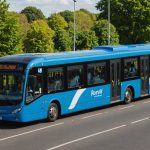Unlock Your Savings: The Ultimate Guide to Utilizing UK Park and Ride Solutions for Cost-Effective City Commuting
What is Park and Ride?
Park and Ride is a clever transport scheme designed to make your city commuting easier, more affordable, and environmentally friendly. The concept is simple: you park your car in a designated area on the outskirts of the city and then use public transport to complete your journey to the city centre. This approach not only reduces traffic congestion and parking hassles but also helps in improving air quality in urban areas.
Benefits of Using Park and Ride
Cost Savings
Using Park and Ride can significantly cut down your commuting costs. Here are a few ways you can save:
This might interest you : The ultimate guide to choosing the ideal motor oil for high-mileage vehicles in the uk
- Parking Fees: Parking in city centres can be expensive. Park and Ride sites often offer free or low-cost parking, which can save you a substantial amount over time.
- Fuel Costs: By driving only to the Park and Ride site and then using public transport, you reduce the amount of fuel you use, saving money on petrol and lowering your carbon footprint.
- Public Transport Costs: Many Park and Ride schemes offer discounted fares for public transport when you park at their sites, making your overall commute more economical.
Reduced Traffic Congestion
Park and Ride helps in reducing the number of cars entering the city centre, which in turn decreases traffic congestion. This makes your journey smoother and faster, whether you are driving to the Park and Ride site or using the bus to get to your destination.
Environmental Benefits
By encouraging the use of public transport, Park and Ride schemes contribute to better air quality in urban areas. Here’s what you can achieve:
Topic to read : Comprehensive handbook for securely transporting your bicycle by car: legal insights for the uk
- Lower Emissions: Fewer cars on the road mean lower emissions, which is beneficial for both the environment and public health.
- Eco-Friendly Transport: Many Park and Ride services are now adopting eco-friendly buses, such as electric or hybrid vehicles, further reducing environmental impact.
How to Use Park and Ride Effectively
Finding Your Nearest Park and Ride
To start using Park and Ride, you first need to find a site near you. Here are some steps to help you get started:
- Online Search: Use online resources like the local government or transport department websites to find Park and Ride sites in your area. For example, in Norwich, you can find detailed information about the various Park and Ride sites, including their locations and services offered[1].
- Mobile Apps: Many cities have mobile apps that help you plan your journey and find the nearest Park and Ride site. For instance, in Plymouth, you can use the Plymouth Citybus and Stagecoach mobile apps for journey planning and live updates[5].
Understanding the Services
Each Park and Ride site offers different services, so it’s important to understand what is available:
- Parking Facilities: Check the number of parking spaces, availability of electric vehicle charging points, cycle parking, and other amenities like recycling facilities and baby-changing areas.
- For example, the Harford Park & Ride in Norwich has 1088 car parking spaces, including electric vehicle charging points and cycle parking[1].
- Public Transport Options: Know the bus routes and frequencies from the Park and Ride site to the city centre. Some sites may also offer additional services like bike share schemes or connections to other public transport modes.
- In Norwich, the Thickthorn Park & Ride site is open 7 days a week and offers connections to the city centre and other key destinations[1].
Examples of Successful Park and Ride Schemes
Norwich Park and Ride
The Norwich Park and Ride scheme is one of the largest and most successful in the UK. Here are some key features:
- Multiple Sites: Norwich has six Park and Ride sites, each with a significant number of parking spaces. The Thickthorn site, for instance, has 726 spaces and is open 7 days a week[1].
- Comprehensive Services: The scheme offers a wide range of services, including connections to the city centre, Norfolk County Hall, the University of East Anglia, and the Norfolk and Norwich University Hospital[1].
- Awards and Recognition: The Norwich Park and Ride scheme was awarded the British Parking Association Park and Ride award in 2004, highlighting its excellence in providing efficient and user-friendly services[1].
Leeds Park and Ride
Leeds also has a well-organized Park and Ride system:
- Free Parking: All three Park and Ride sites in Leeds (Elland Road, Temple Green, and Stourton) offer free parking, making it an attractive option for commuters[4].
- Modern Facilities: The sites are equipped with staffed, heated waiting facilities, ticket machines, toilets, and baby-changing areas. They also offer free Wi-Fi on all buses and electric vehicle charging points[4].
- Family-Friendly: Up to three children can travel free with every fare-paying adult, making it a cost-effective option for families[4].
Practical Tips for Using Park and Ride
Plan Your Journey
Before you start using Park and Ride, plan your journey to ensure a smooth commute:
- Use Journey Planners: Utilize online journey planners or mobile apps to find the best route and schedule for your commute.
- Check Timetables: Always check the timetables for the bus services from the Park and Ride site to the city centre to avoid any delays.
Combine with Active Travel
You can further enhance your commute by combining Park and Ride with active travel options:
- Cycling: Many Park and Ride sites offer cycle parking facilities. Consider cycling from the Park and Ride site to your final destination if it’s within a reasonable distance.
- “Cycling is a great way to get some exercise and reduce your carbon footprint. By combining it with Park and Ride, you can make your commute even more eco-friendly,” says a regular user of the Norwich Park and Ride.
- Walking: If the distance is manageable, walking from the bus stop to your final destination can be a healthy and cost-effective option.
Future Developments and Innovations
Expansion and Upgrades
Many Park and Ride schemes are undergoing expansions and upgrades to improve services:
- Postwick Hub Development: In Norwich, there are plans to add 500 more parking spaces to the Postwick Park and Ride site as part of the Postwick Hub development associated with the Norwich Northern Distributor Road[1].
- Eco-Friendly Buses: There is a growing trend towards using eco-friendly buses in Park and Ride services. For example, the Stourton Park & Ride in Leeds uses fully solar-powered, zero-emission electric buses[3].
Integration with Other Transport Modes
Park and Ride is increasingly being integrated with other transport modes to provide seamless travel experiences:
- Train Connections: Some Park and Ride schemes are being linked with train services. For instance, East Midlands Railway offers combined Park & Ride tickets that include parking and train travel, making long-distance commutes more convenient[2].
Park and Ride is a versatile and cost-effective solution for city commuting, offering numerous benefits from cost savings to environmental advantages. By understanding how to use these schemes effectively, planning your journey, and combining them with active travel options, you can make your daily commute more efficient and sustainable.
Key Takeaways
- Cost-Effective: Park and Ride can save you money on parking, fuel, and public transport costs.
- Environmental Benefits: It helps reduce traffic congestion and emissions, contributing to better air quality in urban areas.
- Convenient: Modern facilities and integrated services make Park and Ride a convenient option for commuters.
- Future-Proof: Ongoing expansions and innovations, such as the use of eco-friendly buses, ensure that Park and Ride remains a viable and sustainable transport solution.
Whether you are commuting to work, school, or any other destination in the city, Park and Ride is definitely worth considering. So next time you plan your journey, think about how you can unlock your savings and contribute to a more sustainable urban transport system.
Detailed List of Benefits
- Cost Savings:
- Reduced parking fees
- Lower fuel costs
- Discounted public transport fares
- Environmental Benefits:
- Lower emissions
- Reduced traffic congestion
- Use of eco-friendly buses
- Convenience:
- Modern facilities at Park and Ride sites
- Integrated public transport services
- Free Wi-Fi and other amenities on buses
- Health Benefits:
- Opportunities for cycling and walking
- Reduced stress from avoiding city centre traffic
Comparative Table: Park and Ride Schemes in Different Cities
| City | Number of Sites | Parking Spaces | Public Transport Options | Additional Amenities |
|---|---|---|---|---|
| Norwich | 6 | Over 5,000 | Bus services to city centre, Norfolk County Hall, UEA, NNUH | Electric vehicle charging, cycle parking, recycling facilities[1] |
| Leeds | 3 | Free parking | Bus services to city centre | Staffed waiting facilities, free Wi-Fi, electric vehicle charging[4] |
| East Midlands | 2 | Combined parking and train tickets | Train connections | Integrated ticketing system[2] |
Quotes from Users
- “Using Park and Ride has saved me so much money on parking and fuel. It’s also reduced my stress levels since I don’t have to deal with city centre traffic,” says a commuter from Norwich.
- “The facilities at the Leeds Park and Ride sites are excellent. The free Wi-Fi and heated waiting areas make my commute very comfortable,” notes a regular user of the Leeds Park and Ride.
- “I love that I can combine Park and Ride with cycling. It’s a great way to get some exercise and reduce my carbon footprint,” says an eco-conscious commuter.











